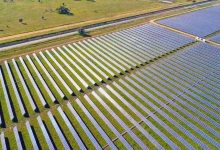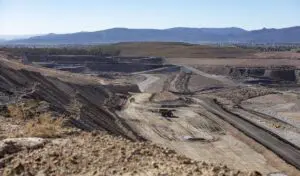Two of the country’s biggest transmission companies have joined forces with the South Australia Liberal government to argue that the prospect of more wind and solar projects, a significant cut to gas fired generation and lower prices will justify the increased costs of the proposed new transmission link to NSW.
Electranet and Transgrid have submitted new documents to the Australian Energy Regulator, outlining the case for the Project EnergyConnect, which would provide a 900km, 800MW link between the renewables dominated South Australia grid and the (for now) coal dominated NSW grid.
The documents show that the anticipated cost of the new link has ballooned from the original estimate of around $1.5 billion to $2.4 billion.
But the two transmission companies say new modelling shows the new link will deliver even greater net market benefits because it would unlock major new wind and solar projects, significantly reduce the need for gas-fired generation, and deliver savings of more than $100 a year to each South Australian household and a total of $180 million a year to NSW households.
It has received the support of the South Australia state government, with energy minister Dan van Holst Pellekaan declaring it would unlock huge projects and ensure the state reaches the Liberal government’s target of net 100 per cent renewables even earlier than planned.
“The inter-connector allows us to reach our net-100% renewables goal sooner, whilst securing our grid and delivering bill relief to South Australians,” van Holst Pellekaan says in a statement.
“The interconnector will create hundreds of jobs, unlock billions of dollars-worth of investment and deliver cleaner, more reliable and more affordable energy for South Australians,” Premier Steven Marshall added.
Among those projects cited by the South Australia government are the “mammoth” $3 billion Goyder South wind, solar and battery project, and the expansion of Lincoln Gap wind and solar project near Port Augusta. There are numerous other projects also in the wings.
The pitch by the South Australian Liberal government is in stark contrast to its federal conservative colleagues, who have focused not on renewables but on a gas-led “transition”. Prime minister Scott Morrison and energy minister Angus Taylor argue that gas power will lower prices and boost reliability.
The South Australia government and the two transmission companies essentially argue the opposite. Indeed, the new modelling for the transmission link, and separate modelling by the Australian Energy Market Operator, reveals the folly of the “gas transition” idea, because both point to gas being further reduced to a very minor role in a grid dominated by renewables.
South Australia, already at more than 57 per cent renewables over the past year, intends to reach “net 100 per cent” renewables within a few years. Gas will be relegated to a very minor role. And on Australia’s grid, AEMO predicts a 94 per cent share for renewables by 2040 in its step change scenario, and a similarly small role for gas.
The huge increase in costs for Project EnergyConnect is attributed to increased costs for poles and wires and associated equipment, but also to changes in the route and access roads to avoid culturally sensitive areas and other issues.
But the two transmission companies say that new modelling by ACIL Allen shows the savings are even bigger than before, thanks to the reduction in wholesale electricity prices (an average fall of $14/MWh) driven by the anticipated increase in wind and solar, and the reduction of gas-fired generation, which will slump from a recent share of more than 40 per cent of South Australia’s electricity needs, to less than 10 per cent.
“Project EnergyConnect will deliver cheaper electricity, more renewable energy and is an important measure to addressing emerging security risks in the network,” ElectraNet CEO Steve Masters says in a statement.
“Since we completed our original analysis on this project, there has been significant changes to the energy market and the cost of transmission across the National Electricity Market (NEM).
“At an updated project cost of $2.4 billion, the cost benefit analysis shows Project EnergyConnect continues to deliver positive net market benefits and remains the preferred option to satisfy the requirements of the AER. More renewable energy will be unlocked as result of the project, resulting in further downward pressure on prices.”
Transgrid says the new link will allow “the free flow of electricity between NSW and SA for the first time in Australia’s history”, and plug a gap in Australia’s energy system.
“EnergyConnect will lower NSW electricity bills by increasing competition in the wholesale electricity market and it will also create a more secure system that is resilient at times of high demand and in periods of extreme weather,” CEO Paul Italiano says in a statement.
And it promises more than just the $180 million in savings for NSW households.
It says it will create 1,500 jobs, inject more than $4 billion into the economy, and modelling by London-based FTI showed it would deliver benefits beyond those normally analysed by regulators, including $6.8 billion to $14.7 billion of long term benefits that would accrue after the end of the regulatory consideration and additional “non monetised” benefits such as renewables integration and system security, such as the benefits to proposed renewable energy zones.
Still, the project is no sure thing. It faces delays and scrutiny as it works its way through the laborious regulatory regime in Australia. To further complicate matters, Transgrid – in an effort to cushion the significant rise in costs on its side of the project (from $1.2 billion to more than $1.9 billion) – is asking for a rule change that will allow it to fast-track revenues so it can defray the costs of financing.
That procedure requires approval of the Australian Energy Market Commission, while the AER will work through the final documents filed by the two transmission network operators, known as their Contingent Project Applications.
The project comprises of a new 330-kV electricity inter-connector between Robertstown in South Australia, and Wagga Wagga in New South Wales, and a short 220-kV spur from Buronga, in New South Wales, to Red Cliffs in northwest Victoria. It is designed to unlock renewable energy projects in South Australia, NSW and potentially Victoria, and is a key component of AEMO’s 20-year blueprint, the Integrated System Plan.











